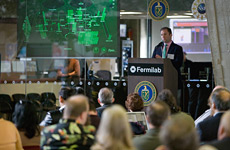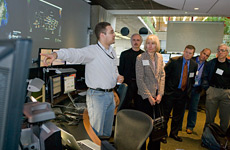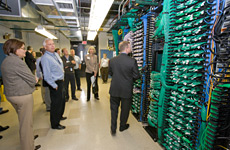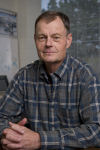|
Wednesday, Oct. 8
11:30 a.m.
Traffic Safety Seminar - One West
Speaker: Delila Huerta, Illinois State Trooper
Title: Safe Winter Driving
2:00 p.m.
Special Seminar - Hermitage, ICB 2nd Flr East
Speaker: Bradford Smith, General Atomics
Title: Mu2e Magnet Status
3:30 p.m.
DIRECTOR'S COFFEE BREAK - 2nd Flr X-Over
4:00 p.m.
Fermilab Colloquium - One West
Speaker: George Atkinson, Institute on Science for Global Policy (ISGP), University of California
Title: Science and Technology in Global 21st Century Societies
Thursday, Oct. 9
THERE WILL BE NO PHYSICS AND DETECTOR SEMINAR THIS WEEK
2:30 p.m.
Theoretical Physics Seminar
- Curia II
Speaker: Ruth Britto, Fermilab
Title: Unitarity for Loop Amplitudes
3:30 p.m.
DIRECTOR'S COFFEE BREAK - 2nd Flr X-Over
THERE WILL BE NO ACCELERATOR PHYSICS AND TECHNOLOGY
SEMINAR TODAY
Click here for NALCAL,
a weekly calendar with links to additional information. |
|
Wednesday, Oct. 8
- German tomato soup
- Corned beef reuben
- German style kielbasa
- Pork chops German style
- German chicken sandwich
- Assorted sliced pizza
- Cavatappi pasta w/Italian sausage & tomato Ragu
Wilson Hall Cafe Menu |
|
Wednesday, Oct. 8
Lunch
- Northern Italian lasagna
- Caesar salad
- Cassata
Thursday, Oct. 9
Dinner
- Closed
Chez Leon Menu
Call x4598 to make your reservation.
|
|
|
GridFest celebrates key part of the LHC experiments

Steve Cotter of ESnet addresses the crowd at Fermilab during GridFest Friday.

GridFest participants learn how the Remote Operations Center at Fermilab interfaces with the CMS experiment at CERN.
At full power, the experiments at the Large Hadron Collider at CERN will produce enough data to fill about 3 million DVD's each year.
To handle this unprecedented amount of information, international partnerships of collaborators at the LHC developed the Worldwide LHC Computing Grid, which benefits a variety of sciences.
Fermilab contributes to the LHC grid system the use of 4,000 processing cores
from 1,100 machines with 2.5 million gigabytes of disk storage and 4.7 million
gigabytes of tape storage. Fermilab along with U.S. universities provides more
than 30 percent of the computing capacity for the CMS experiment at the LHC.
In addition, through its local FermiGrid campus infrastructure, Fermilab serves as the single largest contributor of computing resources to the Open Science Grid, the U.S. portion of the grid, which provides computing power beyond just what is needed for the LHC.
On Friday administrators, computing specialists and physicists from CERN, TRIUMF and Fermilab gathered via videoconference to celebrate the LHC grid’s successful startup.
“Before this project, scientific data centers were essentially silos tightly controlled by local administrators,” said Robert Aymar, director general of CERN. “(The grid) has enabled, for the first time, researchers to collaborate from their home countries, sharing resources located at universities and laboratories with others around the world.”
Particle physics researchers developed the grid as an international network of computers from more than 100 institutions that share processing power and data storage space with remote users. Data processing jobs that might take weeks or months to process on the computers available in a single laboratory can now be analyzed in hours by distributing the work among hundreds of connected machines.
Researchers in fields other than high-energy physics already use the grid to complete tasks such as running simulations that will help develop drugs to combat malaria, avian flu, HIV and AIDS. Andrew Schultz of SUNY Buffalo told the GridFest crowd that he started using the grid to process data from chemical engineering experiments in January. Since then he has completed 60,000 jobs using the grid.
Other GridFest participants also stressed the limitless research applications of the grid for high-energy physics as well as life and enviornmental sciences.
“I have no doubt that what we’re doing here is going to have a significant impact on other sciences,” said Miron Livny, a professor of computer science at the University of Wisconsin-Madison, a principal investigator with Open Science Grid.
-- Kathryn Grim

GridFest participants tour the Grid Computing Center at Fermilab.
|
University of Chicago physicist Yoichiro Nambu wins Nobel Prize
From Chicago Tribune, Oct. 7 2008
After emerging as a young man from the chaos of World War II in Japan, University of Chicago physicist Yoichiro Nambu found order in the idea that our imperfect world contains deep and hidden symmetries, which await only the right mind to reveal them.
Nambu, 87, was woken up early Tuesday with news that he had received the Nobel Prize for physics in recognition of work from the 1960s that many peers described as decades ahead of its time. He took half of the $1.4 million award, with the rest going to Japanese researchers Makoto Kobayashi and Toshihide Maskawa for their work in predicting a third family of the subatomic particles called quarks.
Read more
|
Europeans Think Big for Particle Detectors
From Science, Oct. 2008
European physicists who study particles from outer space made a pitch this week for the ambitious and costly experiments they want to build over the next decade. "We've worked hard to get the tools; now we need to move to large-scale detectors," says Christian Spiering of DESY, Germany's particle physics lab in Hamburg.
Astroparticle physicists aim to snare the likes of cosmic rays, neutrinos, gravitational waves, and dark matter particles as they pass by or through Earth. To better capture these elusive cosmic signals, ASPERA, a network of astroparticle physicists funded by the European Union, this week released a road map for future projects, along with a pitch to funding agencies to double the current €70 million annual spending on astroparticle physics over the next 8 to 10 years--a tall order in what's expected to be a tough funding climate.
Researchers have been detecting particles from space for decades, but so far the scientific breakthroughs from their sensors have been few. But this groundwork will soon pay off, says Spiering, who chairs ASPERA's road map committee. The road map, released on 29 September, divides the field into seven areas and identifies a key instrument in each.
Three of those instruments rely on tested technology, and construction could begin on them soon. First, the proposed Pierre Auger Observatory North, a vast array of detectors that would look for ultrahigh-energy cosmic rays, would likely be a bigger Northern Hemisphere version of the existing Auger array in Argentina. Second, the Cerenkov Telescope Array would look for incoming high-energy gamma rays, following the detection strategy of existing telescopes such as MAGIC in the Canary Islands. And the recently completed ANTARES, a neutrino observatory on the Mediterranean seabed, is the prototype for the third, KM3NeT, which would use a cubic kilometer of seawater as its detector. For these three proposals, "we have the technology; now we have to find the money," says ASPERA coordinator Stavros Katsanevas of France's CNRS research agency.
Read more
|
|
|
Changing Times
Roger Dixon, head of the Accelerator Division, wrote this week's column.

|
| Roger Dixon |
We just completed an extremely successful FY2008. We exceeded our luminosity goal for the Tevatron experiments and set a record for the number of collisions delivered in a year. Slip stacking in the Main Injector was successful with the result that NuMI ran routinely at 250 kilowatts. The MiniBooNE and SciBooNE collaborations had very successful runs. We just achieved our goal of 2 x 1020 protons delivered to NuMI.
Despite all of these successes, there is some uncertainty among the AD staff concerning what they will be doing when the Tevatron Collider program comes to an end in the next couple of years.
Our accelerator-based physics program will move toward the intensity frontier. Our employees wonder, of course, how this transition will affect their work. In the Accelerator Division it is already clear that our scientific, engineering and technical staff will face a big challenge in order to keep up with many new demands as we embark on these new projects. Our staff has the necessary experience to safely build accelerators and to make them work. The NOvA experiment, which just received CD-2 approval, is the first of several experiments planned. The NOvA experiment calls for a 700 kilowatt beam. This requires upgrades to the Main Injector and changes to the Recycler. The proposed Project X is the next step. It would require the construction of a new accelerator that provides beams for a whole new generation of neutrino and rare-decay experiments.
Our accelerator operations responsibilities will be diminished for some time. In the years immediately following the collider shutdown, we will only be operating a neutrino program. This has led some to ask about the future of the outstanding individuals now serving in the Operations Department.
I believe this is an easy question to answer. Over the years I have seen many people in the Operations Department move on to other crucial roles in the division. Former operators have become excellent designers, builders, and leaders. For example, I know five present or former operators who became AD department heads. One of them is presently an assistant AD head who has co-authored an excellent textbook on accelerators. Also all of the run coordinators of the past few years are former members of the Operations Department. The experience they got in operations has made them extremely valuable for the laboratory when it comes to designing, building and operating new accelerators.
The strength of our Accelerator Division is the diversity of our talents and our versatility and dedication. This strength will serve us well as we move on to new projects. |
|
Have a safe day!
Town hall meeting with future director general of CERN
Fermilab will host an open town hall meeting with Rolf-Dieter Heuer, the
designated director general of CERN, Oct. 28, at 10:45 a.m. in Ramsey
Auditorium, followed by a reception in the WH Art Gallery (2nd floor) at
noon. The town hall meeting includes a 10-minute presentation by Heuer and
a 60-minute Q&A session. Everyone is invited. Heuer would like to meet with
all members of the U.S. particle physics community.
Photos wanted for labwide party
At the labwide party on Oct. 17, a slideshow on the video screen in the
atrium will show images of people at Fermilab. We are looking for additional
photos of you and your colleagues here at work--in your office or work area,
at a department picnic, during lunch in the cafeteria, etc. Please e-mail
your jpeg files to lwp08@fnal.gov by Friday, Oct. 10. Depending on the number
of photos we will receive, we might not be able to include every photo
in the slideshow.
Access 2003: Advanced class offered
The Office for Professional Development is offering an Access 2003: Advanced
computer classes Oct. 29. This one-day class will provide you with advanced
capabilities of Access to work with improperly structured data, perform
summary operations on data, create macros to automate tasks and enhance
forms and reports. Click here to enroll or for more information.
Learn about disability workplace inclusion
October is National Disability Employment Awareness Month (NDEAM). Although
this October marks the 61st year that our country has celebrated employment
opportunities for people with disabilities, it was not until Feb. 1, 2001,
when President George W. Bush announced his disability agenda, the New
Freedom Initiative, that a President focused on full inclusion of people
with disabilities in all aspects of society, including the workplace. Click
here to learn more about inclusive workplaces.
NALWO Lincoln Park Zoo trip
NALWO, Fermi National Accelerator Laboratory women's organization, will host a trip to Lincoln Park Zoo on Sunday, Oct. 19, from 9 a.m. to 3 p.m. The event is open to anyone associated with the laboratory and their families. A chartered school bus will leave from the Lederman Education Center at 9 a.m. and will return at approximately 3 p.m. The tour cost is $3 a person, but free for children under age 2. Paid reservations for this trip are required and will be accepted through Oct. 14. For more information, and to make your reservation, contact Margie Nagaitsev at mnagaitsev@hotmail.com or (630) 232-7308.
Exciting Explorations! child care program offered
Exciting Explorations!, a child care program for children ages 7-12, will take place Oct. 13, Nov. 24, 25 and 26, depending on interest. A summer camp counselor will lead the program, Two snacks and beverages are provided. Please send a sack lunch. Program cost is $25 a day and payment is due upon reservation. Reservations are due Oct. 8 for the Oct. 13 program and Nov. 19 for the November dates. To register or for more information, contact Mary or Patti in the Children's Center at x3762 or e-mail daycare@fnal.gov.
Flu shot clinics for 2008 season
Use the east entrance of each building for the following clinics: ES&H training room; Oct. 14 from 9 to
11:30 a.m. in the Industrial Center Building's main floor lunch room;
Oct. 21 from 9 to 11:30 a.m. Wilson Hall, ES&H training room.
Active full-time employees, term employees and temporary employees are eligible
for the vaccinations. Not eligible are: contractors, family members of
employees, visitors/experimenters, seasonal employees, dayworkers,
on-call employees and retirees. Register online at
the ES&H homepage
or call ext. 3232. Bring your Fermilab ID card and a completed consent form
from the ES&H homepage. Wear a loose-fitting shirt. Pregnant employees
need a note from a doctor.
New Travel Office form effective Oct. 1
Effective Oct. 1, the Travel Office and Accounting Department will
discontinue the use of the four-part Travel Authorization/ Expense Voucher
(TA/EV). For trips approved on or after Oct. 1, employees should use the
new TA/EV Excel spreadsheet for travel authorization, travel advance and
travel settlement. Trips approved prior to Oct. 1 on the old four-part form
should be completed on that form.
The new form has a procedure section that outlines the travel approval,
advance and reimbursement process. The form is available on the Accounting and Travel Office Web sites.
Additional Activities
|
|